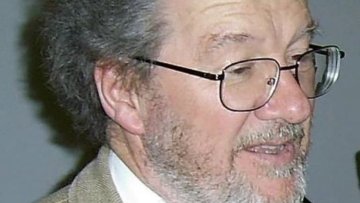Congratulations to the Oxford Mathematicians who have just been awarded LMS prizes.
Homogenization of the eigenvalues of the Neumann-Poincaré operator
Abstract
In this presentation, we investigate the spectrum of the Neumann-Poincaré operator associated to a periodic distribution of small inclusions with size ε, and its asymptotic behavior as the parameter ε vanishes. Combining techniques pertaining to the fields of homogenization and potential theory, we prove that the limit spectrum is composed of the `trivial' eigenvalues 0 and 1, and of a subset which stays bounded away from 0 and 1 uniformly with respect to ε. This non trivial part is the reunion of the Bloch spectrum, accounting for the collective resonances between collections of inclusions, and of the boundary layer spectrum, associated to eigenfunctions which spend a not too small part of their energies near the boundary of the macroscopic device. These results shed new light about the homogenization of the voltage potential uε caused by a given source in a medium composed of a periodic distribution of small inclusions with an arbitrary (possibly negative) conductivity a surrounded by a dielectric medium, with unit conductivity.
15:00
Breakdown Resilience of Key Exchange Protocols
Abstract
Broken cryptographic algorithms and hardness assumptions are a constant
threat to real-world protocols. Prominent examples are
hash functions for which collisions become known, or number-theoretic
assumptions which are threatened by advances in quantum computing.
Especially when it comes to key exchange protocols, the switch to
quantum-resistant primitives has begun and aims to protect today’s
secrets against future developments, moving from common Diffie–Hellman
based solutions to Learning-With-Errors-based approaches. Remarkably,
the authentication step in such protocols is usually still carried out
with quantum-vulnerable signature schemes. The intuition here is that
the adversary would need to break this protocol primitive today, without
having quantum power yet. The question we address here is if this
intuition is justified, and if so, if we can show this rigorously. We
particularly consider the authenticated variant of the recently
introduced post-quantum secure key exchange protocol NewHope (Alkim et
al., USENIX Security 2016), as well as by TLS 1.3, which is currently
being developed by the Internet Engineering Task Force.
Error analysis for a diffuse interface approach to an advection-diffusion equation on a moving surface
Abstract
We analyze a fully discrete numerical scheme for solving a parabolic PDE on a moving surface. The method is based on a diffuse interface approach that involves a level set description of the moving surface. Under suitable conditions on the spatial grid size, the time step and the interface width we obtain stability and error bounds with respect to natural norms. Test calculations are presented that confirm our analysis.
New Formulations for Generator Maintenance Scheduling in Hydropower Systems
Abstract
Maintenance activities help prevent costly power generator breakdowns but because generators under maintenance are typically unavailable, the impact of maintenance schedules is significant and their cost must be accounted for when planning maintenance. In this paper we address the generator maintenance scheduling problem in hydropower systems. While this problem has been widely studied, specific operating conditions of hydroelectric systems have received less attention. We present a mixed-integer linear programming model that considers the time windows of the maintenance activities, as well as the nonlinearities and disjunctions of the hydroelectric production functions. Because the resulting model is hard to solve, we also propose an extended formulation, a set reduction approach that uses logical conditions for excluding unnecessary set elements from the model, and valid inequalities. Computational experiments using a variety of instances adapted from a real hydropower system in Canada support the conclusion that the extended formulation with set reduction achieves the best results in terms of computational time and optimality gap. This is joint work with Jesus Rodriguez, Pascal Cote and Guy Desaulniers.
A robust and efficient adaptive multigrid solver for the optimal control of phase field formulations of geometric evolution laws with applications to cell migration
Abstract
In this talk, I will present a novel solution strategy to efficiently and accurately compute approximate solutions to semilinear optimal control problems, focusing on the optimal control of phase field formulations of geometric evolution laws.
The optimal control of geometric evolution laws arises in a number of applications in fields including material science, image processing, tumour growth and cell motility.
Despite this, many open problems remain in the analysis and approximation of such problems.
In the current work we focus on a phase field formulation of the optimal control problem, hence exploiting the well developed mathematical theory for the optimal control of semilinear parabolic partial differential equations.
Approximation of the resulting optimal control problem is computationally challenging, requiring massive amounts of computational time and memory storage.
The main focus of this work is to propose, derive, implement and test an efficient solution method for such problems. The solver for the discretised partial differential equations is based upon a geometric multigrid method incorporating advanced techniques to deal with the nonlinearities in the problem and utilising adaptive mesh refinement.
An in-house two-grid solution strategy for the forward and adjoint problems, that significantly reduces memory requirements and CPU time, is proposed and investigated computationally.
Furthermore, parallelisation as well as an adaptive-step gradient update for the control are employed to further improve efficiency.
Along with a detailed description of our proposed solution method together with its implementation we present a number of computational results that demonstrate and evaluate our algorithms with respect to accuracy and efficiency.
A highlight of the present work is simulation results on the optimal control of phase field formulations of geometric evolution laws in 3-D which would be computationally infeasible without the solution strategies proposed in the present work.





